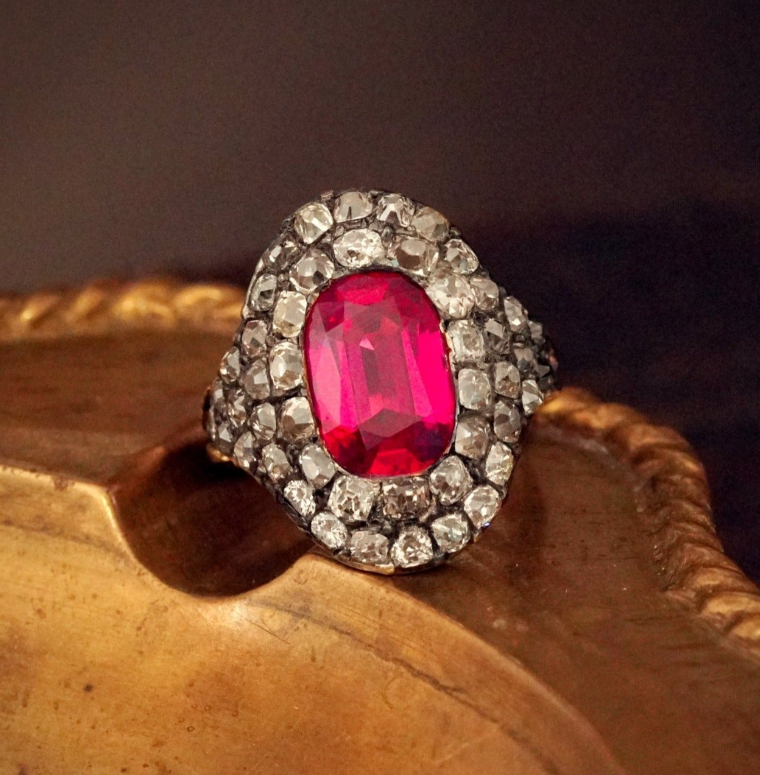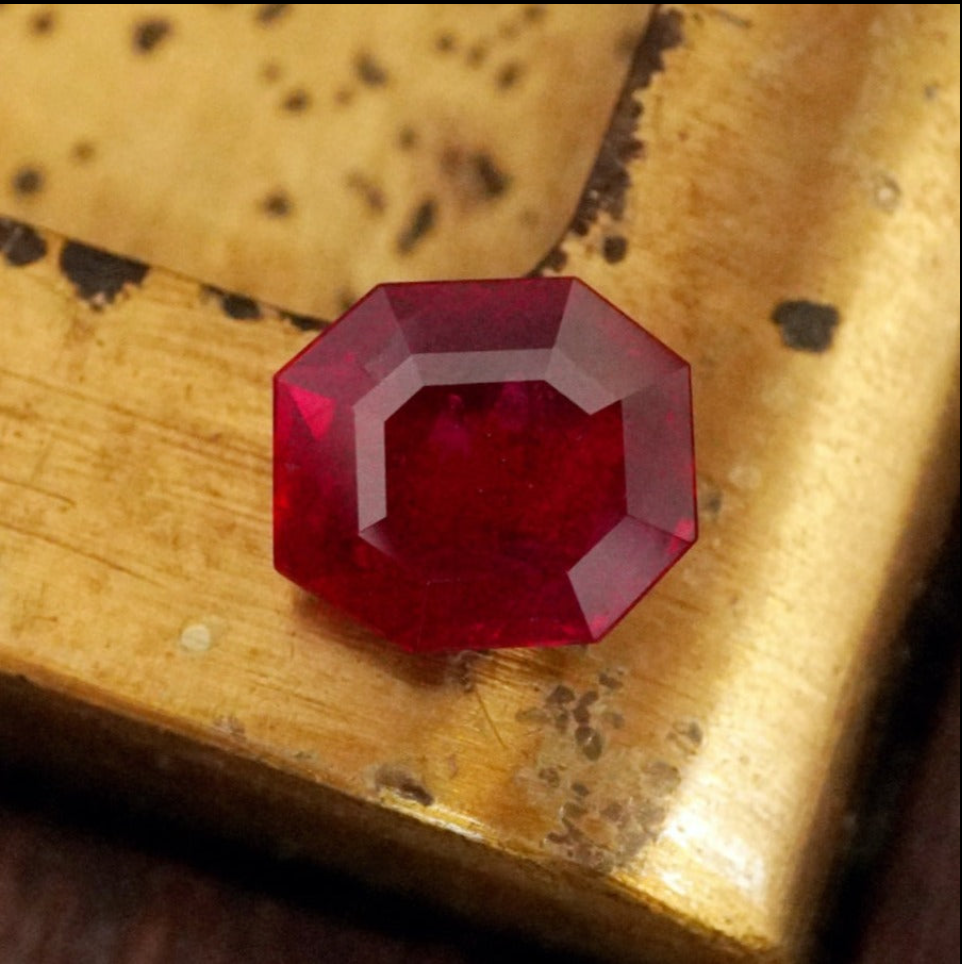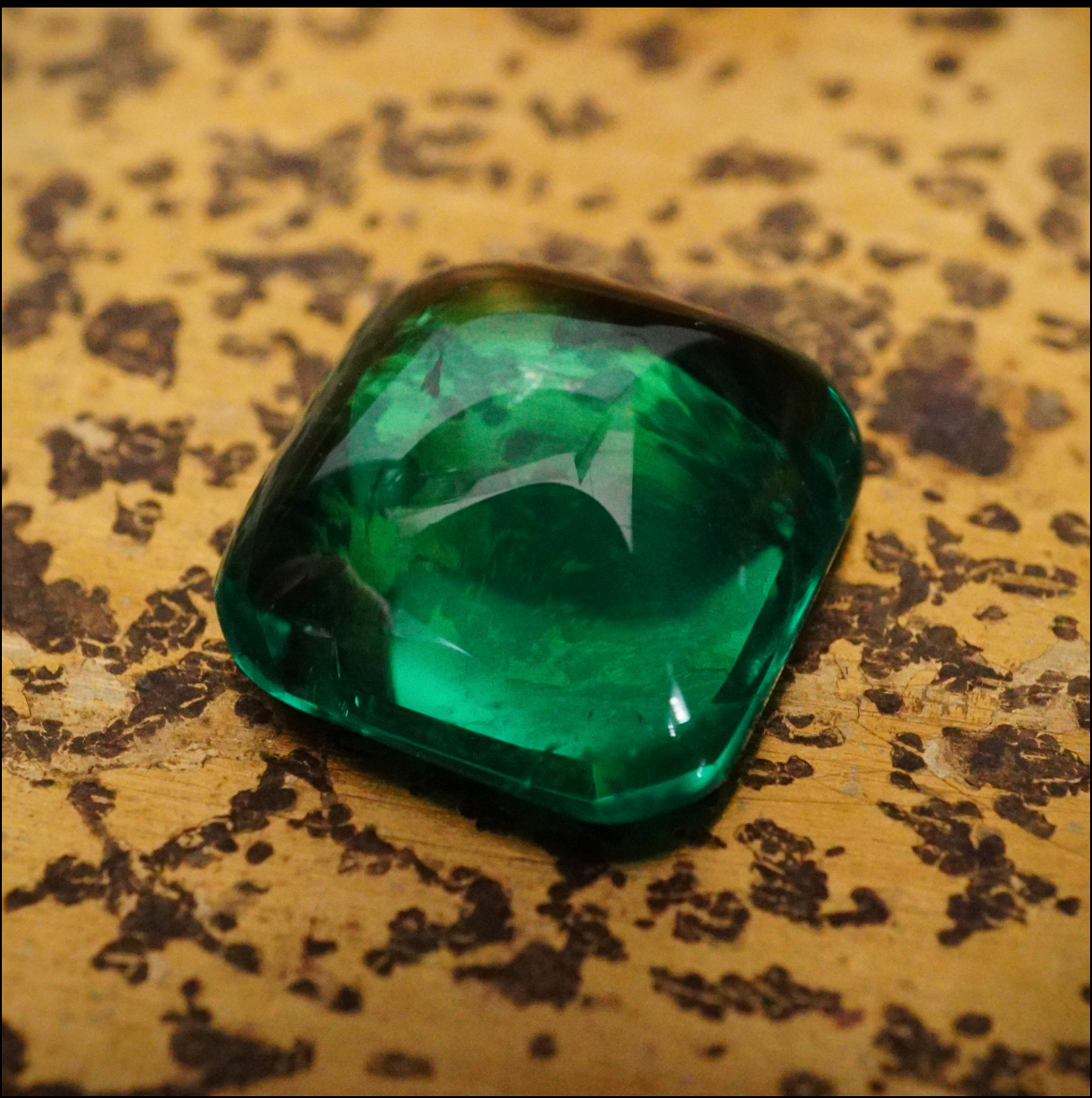
Understanding Oiling in Colombian Emeralds
Emeralds hold a unique enchantment in the world of gemstones. In addition to their vibrant green hues and rich history, some of the most prized emeralds exhibit attractive “imperfections” as a result of their natural growth process that contribute to their charm rather than detract from their value as they would in other gems. These internal features, often referred to as “jardin”(French for garden), create mesmerizing patterns within the stones, lending each emerald a distinct character akin to a lush garden.
Not all emeralds emerge from the earth with their beauty fully revealed, however. Many, including those from the revered mines of Colombia, require a gentle touch to enhance their natural allure and make them more marketable, and this is where the art of emerald oiling comes into play. Let’s explore what oiling is in emeralds, its purpose, the types and categories of oiling, and the treatment’s overall significance in the world of gemstones.
What Is Oiling in Emeralds and Why Is It Important?
Despite their inherent beauty, certain emeralds have visible imperfections or lackluster coloration due to inclusions in the stone. In gemological terms, “inclusions” refer to any material that’s trapped inside a gemstone during its creation. This can encompass a wide range of features, including other minerals, gases, liquids or even structural irregularities within the gemstone’s crystal lattice. Two common types of inclusions in emeralds are fractures and fissures. These are essentially breaks or cracks within the stone that can occur naturally during its formation process.
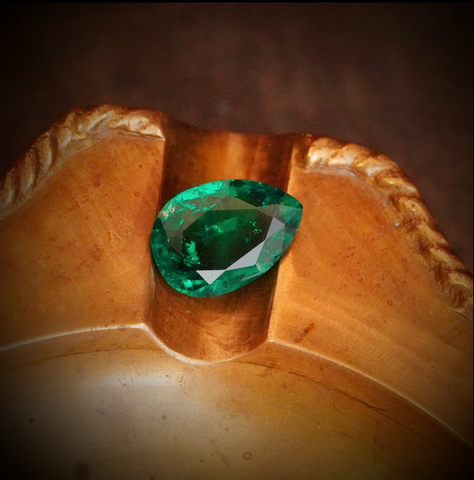
6.66-carat, pear-shaped Colombian emerald with no oil
Oiling, a time-honored and freely disclosed practice in the gemstone industry, minimizes the visibility of these natural imperfections by filling them with a colorless and transparent oil or resin. As a result, the clarity of an emerald is greatly improved, making it look more transparent and improving its overall aesthetic appeal. Oiling can also improve an emerald’s color by reducing the appearance of color zoning (irregular distribution of color within the stone). Oiling also intensifies an emerald’s color because fewer apparent flaws are blocking the passage of light.
Oiling not only allows these captivating green treasures to reach their full potential but also helps protect them from damage. By filling the internal fractures and fissures, an emerald becomes less vulnerable to chipping and breaking, making it more durable and suitable for jewelry use.
Historical Origins of Oiling in Emeralds
The history of oiling in emeralds is a fascinating journey that spans centuries and remains deeply intertwined with the gemstone’s allure. While the exact inventor of this technique remains uncertain, it’s widely believed that the practice of oiling emeralds dates back to ancient times. Early civilizations in the emerald-rich regions of South America, such as the Incas and the Aztecs, were among the first to discover emeralds and likely experimented with methods to enhance their natural beauty. These ancient cultures likely used simple vegetable oils to fill the gem’s fractures.

Jogani original ring featuring a 4.48-carat Colombian emerald with no oil
The more sophisticated practice of emerald oiling, as we know it today, has evolved over time. It gained prominence during the Renaissance era, when gemstone cutters and dealers recognized the value of enhancing emerald clarity and color. The techniques and oils used became more refined and specialized as the gem trade expanded across Europe and Asia.
Types of Oiling
There are two main types of oils used in emerald enhancement:
Traditional Oils
Historically, traditional oils such as cedarwood oil, linseed oil and Canada balsam have been utilized to treat emeralds. These oils, derived from natural sources, possess qualities that make them ideal for emerald enhancement. Cedarwood oil, for example, is prized for its transparency and ability to penetrate deep into the gem’s fractures, thereby improving clarity and color. Linseed oil, extracted from flaxseed, is known for its durability and resistance to yellowing over time. Canada balsam, a resin obtained from the balsam fir tree, is another traditional oil used for emerald treatment, valued for its high refractive index, which, like cedarwood oil, closely matches that of emeralds and therefore appears invisible in the stone.
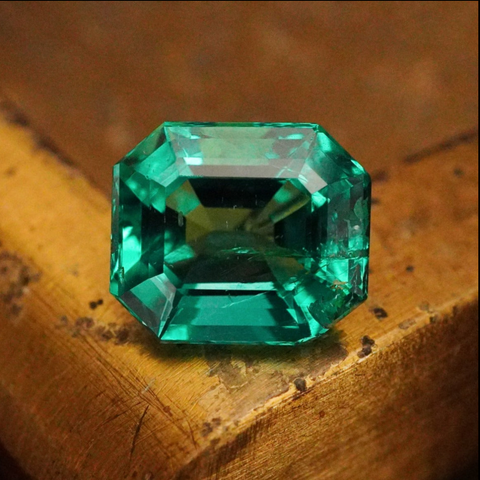
5.11-carat, step-cut Colombian emerald with minor oil
These traditional oils are preferred for their ability to blend seamlessly with the emerald’s natural properties, creating a harmonious enhancement that’s both effective and aesthetically pleasing. While they offer excellent penetration into the gem’s fractures, traditional oils may require periodic re-oiling to maintain their effectiveness, as they can gradually evaporate or degrade over time. However, an emerald with a minimal amount of oil treatment should never normally require re-oiling.
Synthetic Resins
In recent years, synthetic resins have emerged as a popular alternative to traditional oils for emerald enhancement. These synthetic “glue-like” substances are specially formulated to match the refractive index of emeralds, making them virtually invisible within the gem. This optical matching ensures that the filled fractures blend seamlessly with the surrounding gem material, resulting in a natural and uniform appearance.
Synthetic resins offer several advantages over traditional oils. They provide long-lasting enhancement, requiring less frequent re-treatment compared to traditional oils.
Additionally, synthetic resins offer greater stability and durability, making them resistant to degradation over time. This stability ensures that the enhancement remains intact even under harsh environmental conditions or prolonged exposure to light.

Jogani original earrings featuring Colombian emeralds with minor oil
The application of synthetic resins typically involves a meticulous process to ensure optimal results. A small amount of resin is carefully injected into the gem’s fractures, using specialized equipment to ensure precise placement and minimal wastage. Once cured, the resin forms a durable and transparent filling that enhances the emerald’s clarity and appearance without compromising its natural beauty.
Overall, both traditional oils and synthetic resins play a crucial role in emerald enhancement, offering effective solutions to improve the gem’s clarity, color and durability. Whether opting for the time-tested properties of traditional oils or the advanced technology of synthetic resins, gemologists and jewelers can achieve stunning results that enhance the beauty and value of emeralds for generations to come.
The Importance of Full Disclosure
When purchasing an emerald, especially one that’s been enhanced through oiling, full disclosure is paramount. Buyers should be informed about any treatments the emerald has undergone to make an informed decision. Full disclosure ensures transparency and allows buyers to assess the true value and characteristics of the emerald. Additionally, understanding the treatment history of an emerald helps in determining its care requirements and potential longevity.
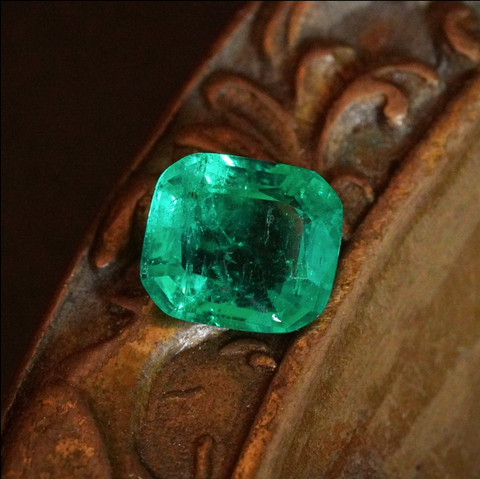
3.2-carat, cushion-shaped Colombian emerald with minor oil
Levels of Emerald Oiling Treatment
Within the gemstone industry, emerald oiling treatments are often categorized into different levels or degrees to provide clarity and transparency to buyers and sellers about the extent of treatment a particular emerald has undergone.
Commonly Recognized Categories
- No Surface-Reaching Fissures Present / No Oil or Insignificant Treatment: This category indicates that the emerald exhibits no surface-reaching fractures or fissures, and either no oiling treatment has been applied, or if applied, it’s negligible and has minimal impact on the gem’s clarity or appearance.
- Minor Treatment: Emeralds in this category may show indications of fissure filling or minor clarity modification. The treatment is minimal and aimed at addressing minor imperfections while maintaining the gem’s natural appearance to the greatest extent possible.
- Moderate Treatment: This level of treatment suggests that the emerald exhibits indications of cavity filling or moderate clarity modification. The treatment may involve more extensive filling of fractures or cavities to enhance clarity and overall appearance.
- Significant Treatment: Emeralds categorized under significant treatment show indications of colored fissure filling or significant clarity and color modification. The treatment may involve extensive filling of fractures or cavities with colored substances to improve both clarity and color.
- Emerald with Resin (Manufactured Product): This category indicates that the real emerald has undergone treatment with synthetic resins, which are manufactured products specifically formulated for gemstone enhancement. Resin treatments may vary in intensity, but they generally aim to improve clarity and color while providing long-lasting enhancement.
It's important to note that gem-quality emeralds are exceptionally rare, and even among these, few are considered flawless. Further, finding a no-oil emerald is also exceptionally rare in the gemstone market, as nearly all emeralds undergo some form of enhancement to improve their clarity and overall appearance. Emeralds with no oil treatment command premium prices due to their exceptional rarity and natural beauty.
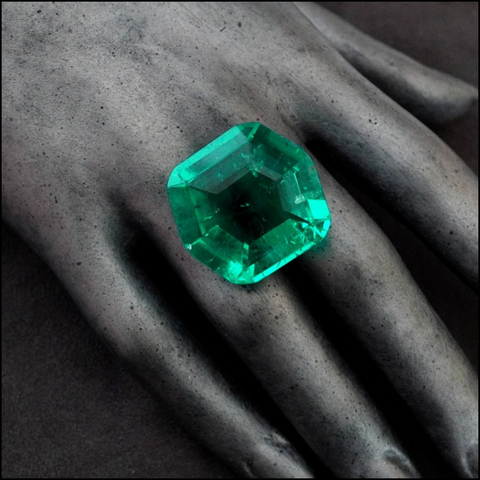
44.66-carat, hexagon-shaped Colombian emerald with no oil
Caring for Oiled Emeralds
Proper care is essential to maintain the beauty and integrity of oiled emeralds. Here are some guidelines for caring for emeralds that have undergone oiling:
- Avoid harsh chemicals: Chemicals found in household cleaners, cosmetics and perfumes can potentially damage the oil or resin filling in the emerald. It’s advisable to remove jewelry before using such products.
- Gentle cleaning: Clean oiled emeralds regularly with a soft, lint-free cloth dampened with mild soapy water. Avoid using ultrasonic or steam cleaners, as they may damage the filling or loosen the gemstone in its setting.
- Avoid extreme temperatures: Sudden temperature changes can cause the oil or resin filling to expand or contract, potentially affecting the gemstone’s appearance. Remove oiled emerald jewelry before exposure to extreme heat or cold.
- Store properly: Store oiled emerald jewelry separately from other jewelry pieces to prevent scratching. Use a soft pouch or lined jewelry box to protect the gemstone from abrasion.
- Periodic inspection: Have oiled emeralds inspected by a qualified gemologist or jeweler periodically to ensure that the filling is intact and the gemstone remains in good condition. Re-oiling may be necessary over time to maintain the gem’s appearance and durability.
By following these care guidelines and seeking professional advice when needed, owners of oiled emeralds can enjoy their beauty for years to come while preserving their value and longevity.

4.27-carat, cushion-shaped Zambian emerald with moderate oil
Oiling in emeralds is a well-established practice, designed to enhance the gem’s natural beauty and resilience. By delicately filling its minute imperfections, either with traditional oils or more modern innovations such as synthetic resins, oiling enriches the clarity, color, and inherent charm of emeralds while safeguarding them against the effects of time. The classification of emerald oiling treatments into distinct categories brings clarity and transparency to the gemstone market, fostering trust and integrity between buyers and sellers. Additionally, understanding the treatment history of an emerald offers invaluable insights for its care and preservation. With gentle care and periodic attention, these adorned emeralds continue to enchant jewelry enthusiasts worldwide, their timeless allure enduring through generations.
Top: 4.69-carat, cabochon Colombian emerald witn no oil
All emeralds from the Jogani collection

